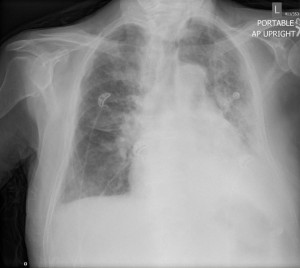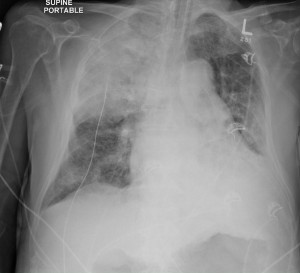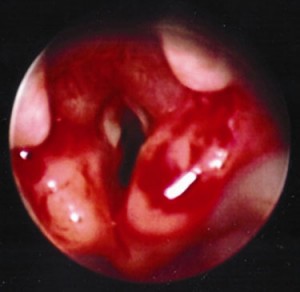Case: 35M was playing ultimate frisbee when he collided with another player in mid-air while battling for the disc. He landed on his neck and was unable to stand up. What are your main considerations and plan while going to see him in the trauma bay?
Aside from usual considerations in trauma, there are special considerations for the spine-injured patient.
Airway – May have facial/head trauma
Breathing – Loss of intercostal muscles (or very high SCI – diaphragm). Many high SCI patients who do not receive medical attention in time will die in the field from hypoventilation.
Circulation – Neurogenic shock – severe hypotension, bradycardia
Disability – Neuro exam must be clearly documented on arrival and motor/sensory reevaluated frequently
Exposure – Maintain body temp during exposure b/c SCI lose heat (sympathectomy) and if quad, get off back board b/c can develop pressure sores within 2 hrs.
Thoracic spine requires much higher energy to disrupt – more likely to have isolated C-spine injury, but if T-L, look for other spine injuries.
Airway considerations:
In awake, spont ventilating cooperative patients, recommended awake FOB technique. Minimizes flex/ex of neck, can check neurovitals.
In obtunded/unconcious patients, three-person team with manual inline stabilization, (+/- cricoid pressure, which has been shown to move C-spine). Can do modified RSI with BMV if unable to preox well. SCH can be given safely if SCI <24 hours. UK guidelines use bougie always (or stylet at least) to maximize first attempt success. Surgical airway less preferred, unless necessary. Most surgeons will delay trach until C-spine has been cleared or fixed.
Ideally, art line pre-induction to maintain MAP > 85. If suspect neurogenic shock, can insert central line for vasopressors (preferably subclavian or femoral).
Breathing considerations:
Resp distress can occur after SCI either due to thoracoabdominal injury or SCI. 25-50% concurrent closed head injury. Conversely, 5-10% of head injury have injury to spine.
With bigh thoracic or cervical SCI, chest can move paradoxically (loss of intercostal innervation above injured level). VC and FRC reduced, as well as ability to clear secretions with coughing.
Neurogenic pulmonary edema can occur – caused by sympathetic discharge 2ry to TBI or SCI.
Circulation considerations:
In addition to usual causes of hypotension and shock in trauma patients, SCI can lead to neurogenic shock.
Spinal shock is characterized by bradycardia, systemic vasodilation, hypotension (from loss of sympathetic innervation). Spinal shock by definition is an acute, reversible injury and refers to the injury of the spinal cord. Neurogenic shock refers to the distributive shock caused by sympathectomy and vasodilation.
Typically associated with injuries at T6 and higher.
~2/3 of C-spine injured patients with SBP <100 have neurogenic shock.
1st line treatment: fluids. Consider PA line, alpha and beta agonists as well as vagolytics (atropine, gylco).
Disability considerations:
Sympathectomy and vasodilation can cause rapid heat loss. Males can develop priapism. A foley catheter should be inserted because acute bladder distention can occur.
All physicians caring for patient should verify and document their own neuro findings. Neuro exam usually shows flaccid paralysis and areflexia in spinal shock.
Exposure and Environmental considerations:
In addition to rapid heat loss, exposure to very hot conditions can also cause hyperthermia.
Therapies to prevent secondary injury:
1) Corticosteroids – in newest 2013 guidelines, steroids are NOT recommended (Level 1)
2) Maintain high BP/MAP – target MAP 85-90 mmHg for the first 7 days post SCI (Level 3). This is to maintain spinal cord perfusion pressure (MAP – CSFP).
3) Avoidance of injury progression – must maintain in-line stabilization to prevent conversion of partial SCI to complete SCI
Timing of surgery? Variable opinions, poor evidence. Most neurosurgeons would consider decompression and instrumentation for a high C-spine injury early (<24 hr) and if incomplete cervical SCI, even earlier (<8-12 hr).
Pre-existing medical risk factors for SCI:
- cervical spondylosis
- atlantoaxial instability
- congenital (e.g. tethered cord)
- osteoporosis
- spinal arthropathies (i.e. ankylosing spondylitis, rheumatoid arthritis)
Bulbocavernosus reflex important to test – anal sphincter tone when squeezing glans penis or tugging on foley. This will be absent in spinal shock, and the return of the reflex signifies the resolution of spinal shock. Spinal shock does not apply to lesions below level of the cord (T12-L4). If there is lumbar burst fracture and absence of bulbocavernosus reflex, consider cauda equina.
Continuation of case: Patient was breathing adequately to not require immediate intubation in the trauma bay. He was brought to OR and intubated with an asleep fiberoptic technique after insertion of awake arterial line. He was placed prone with pins. Neuromonitoring was not utilized (but if MEPs/SSEPs are used, then will need to run TIVA +/- <0.5 MAC, and no paralysis). MAP was difficult to maintain despite very high dose phenylephrine infusions (in hindsight, should have placed central line). At end of case, neurostatus unchanged.
Usually patients are kept intubated at the end of case after awakening for neuroassessment because of concern of airway edema, residual or worsened respiratory function, and C-spine collar being reapplied. Can be extubated more smoothly in ICU with adjuncts available (e.g. extubate over an airway exchange catether).
Guidelines for the management of Acute Cervical Spine and Spinal Cord Injuries 2013
Dr. Scott Weingart’s podcast on the new ATLS guidelines and new spinal cord injury guidelines.



